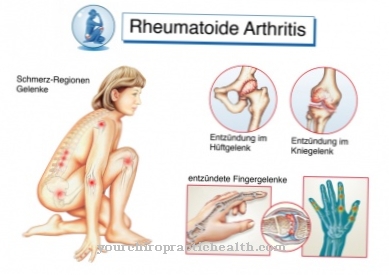The Gorlin-Goltz Syndrome is a very rare genetic disease that is characterized by an increased incidence of basaliomas (white skin cancer). Apart from the constant development of new skin tumors, the course of this condition is different for each patient. Various main and secondary criteria are used to diagnose Gorlin-Goltz syndrome.
What is Gorlin-Goltz Syndrome?

© Christoph Burgstedt - stock.adobe.com
Gorlin-Goltz syndrome is a largely unknown disease due to its extreme rarity. The main symptom is the appearance of several benign and malignant skin tumors in the course of life. Other symptoms include jaw and skeletal abnormalities, cleft lip and palate, or unusual skull shapes.
According to preliminary surveys, around one in 56,000 people is affected by this disease. There are currently around 100 known patients in Germany. However, a larger number of unreported cases is suspected. The Gorlin-Goltz syndrome was first described in 1960 by the American human geneticist Robert James Gorlin and the dermatologist Robert William Goltz.
Other names for the disorder are Gorlin syndrome, Hermans-Grosfeld-Spaas-Valk syndrome or Ward’s Syndrome II. Regarding the symptoms is also from Basal cell nevus syndrome or Nevus epitheliomatodes multiplex spoken. Both sexes are equally affected by the disease.
Sometimes there is confusion in the descriptions with the so-called Goltz-Gorlin syndrome, which is also a genetic skin disease, but takes a completely different course. In addition, Goltz-Gorlin syndrome only affects women because male fetuses die in the womb. The fact that a similar name is used for both diseases can lead to irritation in the literature when describing them.
causes
Several gene mutations can be responsible for Gorlin-Goltz syndrome. A mutation of the tumor suppressor gene PTCH1 on chromosome 9 is known. This gene controls the profiling rate of certain cells (including the basal cells). If this control is omitted due to a mutation in the gene, new basaliomas can constantly develop.
Since the profiling of other cells is also controlled, skeletal and jaw anomalies develop during embryogenesis. Furthermore, new jaw cysts can form continuously in adulthood, which then have to be treated. In the womb, the so-called Hedgehog signaling pathway is responsible for normal development of the embryo.
However, this signal path is normally switched off in adults because an increased profiling rate of the cells is no longer necessary. However, a genetically modified PTCH1 gene can cause this signal path to remain active. As a result, there is an increased rate of cell formation, especially of the basal cells. New skin tumors are constantly forming. Gorlin-Goltz syndrome is inherited in an autosomal dominant manner.
Symptoms, ailments & signs
The Gorlin-Goltz syndrome is essentially characterized by the appearance of new basaliomas. The first skin tumors can appear before the age of 18. However, the main age of onset is between 30 and 50 years of age.
From this point on, new tumors constantly appear, which do not form metastases, but have a destructive effect on the neighboring bone and cartilage tissue. If left untreated, the affected areas will be significantly distorted. There are patients who develop several thousand tumors during their lifetime.
The tumors are mainly located on the face, on the head or on the back. Usually there are abnormalities in the vertebrae and ribs. Pine cysts very often develop over a lifetime. Polydactyly (extra fingers or toes), eye abnormalities, fibromas of the heart or ovaries, cleft lip and palate, deformities of the facial skull, pleural cysts, or medulloblastoma (malignant tumor of the cerebellum) in children can occur. There are calcifications in the falx cerebri.
Diagnosis & course
The diagnosis of Gorlin-Goltz syndrome can be made on the basis of certain clinical criteria. There are main and secondary criteria. For a reliable diagnosis either two main criteria or one main criterion and two secondary criteria must be met.
The main criteria include at least five basaliomas or one basalioma before the age of 30, constant occurrence of jaw cysts, dents on the palm or inner surface of the foot, anomalies on the ribs, meningeal calcifications or the familial occurrence of the syndrome.
Additional criteria are large head circumference, cleft lip and palate, abnormalities in the bones and spine, fibroids on the ovaries or heart, and medulloblastoma. Furthermore, a human genetic test can be used to make the diagnosis by detecting a mutation in the PTCH1 gene.
Complications
In most cases, the Gorlin-Goltz syndrome leads to the development of skin cancer. This cancer can lead to various complaints and complications, which depend heavily on the affected region and the spread of the tumor disease. The tumor can also spread to bone and the surrounding tissue and destroy it.
This leads to severe pain and restricted mobility. Various malformations can occur due to tumors in the face. Often the eyes are also affected, so that the patient can go blind or lose a considerable part of his eyesight due to the Gorlin-Goltz syndrome. The skull becomes deformed and cysts form in different parts of the body.
The treatment of Gorlin-Goltz syndrome is usually carried out by surgical removal of the tumor from the respective sites. Medicines are also administered to the patient. However, there can be no guarantee that the cancer will not recur later in life.
The patient is also dependent on attending preventive examinations so that there is no reduction in life expectancy. In the treatment of Gorlin-Goltz syndrome, in most cases the course of the disease is always positive.
When should you go to the doctor?
A doctor must be consulted in the event of unusual skin abnormalities or changes in the normal skin texture. If there are spots on the skin, swellings, growths or lumps, a doctor's visit is necessary. If the complaints spread or increase in scope, a doctor should be consulted as soon as possible. In Gorlin-Goltz syndrome, the face, head and back are particularly affected by irregularities.
A doctor's visit is necessary as soon as there are problems with the bones, the vertebrae or the cartilage tissue. If pain sets in or if movements are impaired, the symptoms must be clarified by a doctor. If there are open wounds on the body, sterile wound care is necessary. If this cannot be guaranteed, a doctor should be asked for help. A doctor should be consulted in the event of itching, a feeling of tension on the skin or an inner restlessness. If the physical complaints lead to psychological problems, a visit to the doctor is also advisable.
Depressive phases, mood swings and persistent melancholy are considered unusual.Aggressive behavior, changes in personality, or social consideration are warning signs that should be followed up. A therapist is needed if the behavior persists for weeks or months or if it worsens.
Doctors & therapists in your area
Treatment & Therapy
The therapy of the Gorlin-Goltz syndrome consists in the removal of the basal cell carcinoma, orthopedic treatment for bone and vertebral anomalies, surgical removal of jaw cysts and oncopsychological consultations. There are several options for treating basal cell carcinomas.
The first choice therapy is surgical removal of the tumor. This operation is performed under local anesthesia. In this case, healthy tissue is operated on at a safe distance from the edge of the tumor in order to be able to remove as many tumor cells as possible. So-called cryotherapy is also used for some tumors.
This involves freezing the tumor with the help of liquid nitrogen. An extremely cold spray is sprayed onto the tumor, which then dies with crust formation. As a drug alternative, imiquimod cream or 5-fluorouracil cream is applied several times to the tumor.
The imiquimod cream activates the immune system so that it can locally kill the tumor. Treatment with 5-fluorouracil cream is a local chemotherapy. Finally, with photodynamic therapy, the tumor is rubbed with a cream that makes the cancer cells very sensitive to light.
Outlook & forecast
Gorlin-Goltz syndrome has a relatively poor prognosis. In most cases, the disease leads to skin cancer, which is often fatal. Accompanying this, there are often serious complications and health problems that greatly reduce the quality of life and well-being of the person concerned. This can lead to the tumor spreading to the bones or the adjacent tissue, which can lead to restricted mobility, pain and nerve disorders. Most of the time, those affected also go blind and suffer various paralysis over time.
If the tumor is detected early, it may be removed before serious complications set in. The prerequisite for this, however, is that the patient undergoes lengthy radiation therapy or a complicated operation, which in turn is associated with risks. Even if the treatment is successful, the patient is dependent on preventive examinations and drug therapy for the rest of his life.
The outlook and prognosis therefore primarily depend on when the Gorlin-Goltz syndrome is diagnosed and what measures are taken to remove the tumor. In principle, the earlier the tumor occurs, the better the prognosis. Older and sick people have a slightly worse prognosis because the body often continues to degrade as a result of the treatment.
prevention
Since the Gorlin-Goltz syndrome is inherited in an autosomal dominant manner, affected families should seek human genetic counseling. Gorlin-Goltz syndrome can be diagnosed during a prenatal examination.
Aftercare
The options for follow-up care are extremely limited in the case of Gorlin-Goltz syndrome. The patient is primarily dependent on direct medical treatment to prevent further complications. Self-healing cannot occur.
Furthermore, a complete healing cannot be guaranteed, so that it may also lead to a reduced life expectancy of the person affected. Early diagnosis and treatment therefore play a very important role in Gorlin-Goltz syndrome. The syndrome is usually treated with the help of surgical interventions.
After such interventions, those affected should always rest and take care of their own body. In doing so, strenuous activities or stressful activities should be avoided if possible. Medicines can also be taken to combat the symptoms of the syndrome.
Attention should be paid to regular use and possible interactions with other drugs. In some cases, those affected are also dependent on chemotherapy. The support from friends or family is also very helpful and can accelerate healing. Contact with other affected persons can also be very useful.
You can do that yourself
With Gorlin-Goltz syndrome, the patient has no special self-help options. The tumors usually always have to be removed by medical treatment. However, since Gorlin-Goltz syndrome is inherited, patients or their parents should always undergo genetic counseling. This may prevent the syndrome from occurring in future generations.
The tumors are removed by surgery. In some cases, different creams that fight the tumor can also be used. Those affected are often dependent on psychological support. This should primarily be done by a therapist or close friends and family.
Support in everyday life can also have a positive effect on the course of the disease. Here, the person concerned can be accompanied to medical examinations or treatments or can be supported during longer stays in a hospital.
In the case of psychological complaints, discussions with close relatives and friends are always very helpful. Contact with other patients with Gorlin-Goltz syndrome can also be helpful. Children should always be informed about the possible consequences and complications of the disease.


.jpg)
























